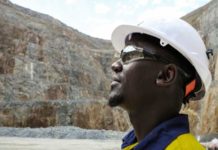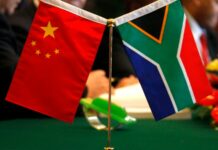
[miningmx.com] — SHEER incompetence within the Department of Mineral Resources (DMR) – or deliberate enemy action?
That’s the question uppermost in the minds of investors and mining executives following the astounding development at Lonmin, where the DMR has forced it to stop sales of base metals.
The implications are truly staggering, particularly because of the similarities between the situation at Lonmin and that at Kumba Iron Ore (Kumba).
Anglo Platinum (AngloPlat) CEO Neville Nicolau said: “We look with some anxiety at what is happening at Lonmin. We are concerned about the damage this is doing to the reputation of South Africa Inc.
“We have spent a lot of time defending the country and the Mining Charter to overseas investors telling them there’s nothing to worry about – and then this kind of thing happens.’
Nicolau said: “As I understand it, Angloplat’s situation is different to Lonmin in that the rights to the associated minerals are specified in the mining licences we have been granted.
“We have not received any instructions from the DMR on this issue.’
Lonmin CEO Ian Farmer told me on Friday afternoon that there had been no further developments since the company released its statement on Thursday evening, in which it said it would apply for an interdict against the DMR order.
He said: “We have spoken to our peers at AngloPlat, Impala Platinum and the Chamber of Mines. They share our concerns and have encouraged us to be resolute in our position over this.’
Impala Platinum CEO David Brown could not be reached for comment.
Among the many incomprehensible aspects of the Lonmin development – as well as the Kumba situation – is that these actions are totally at odds with the stated strategic objectives of Minister of Mineral Resources Susan Shabangu .
Shabangu, DMR director-general Sandile Nogxina and DMR spokesperson Jeremy Michaels could not be reached on Friday. It’s understood Nogxina and Shabangu are currently accompanying President Jacob Zuma on his state visit to Russia.
In June, Shabangu stated her strong intention to improve South Africa’s standing on Canada’s Fraser Institute survey, which ranks countries on their attractiveness as mining destinations.
South Africa has slipped badly down the rankings over the past two years and now sits not far above Zimbabwe.
But it is precisely because of developments like the ones involving Kumba and now Lonmin that the country is rated so poorly by investors, who hate uncertainty and will avoid countries where governments keep changing the goal posts.
I think mining law expert Peter Leon – a partner in legal firm Webber Wentzel – hit the nail on the head when he told me that, “the South African government is speaking with a forked tongue’.
Leon said: “On the one hand, the government is pushing Migdett (the mining, growth, development and employment task team – a tripartite body set up in December 2008 between government, organised labour and the mining industry) to help the mining industry and about which I have been very complimentary, but then they go and do something like this.
“How can this be happening? It’s inconceivable. I don’t think it’s deliberate but at the end of the day it sends out a terrible message.’
Just how terrible will only become clear over time, but a lot of damage has already been done to the country’s investment reputation.
It seems that every time there are positive developments in the SA mining sector – like AngloPlat being awarded its mining right conversions and Gold Fields doing a string of BEE deals – the government promptly shoots itself in both feet yet again.
Simply stated: what investor in his right mind is going to put up the hundreds of millions of dollars required for a new mine in a country where fundamental rules can change like this overnight?
Be very clear that this Lonmin development is a fundamental threat to the financial wellbeing of all platinum companies. Revenue from the associated metals like copper, nickel and chrome is hugely important to the operations.
Remove them and even many currently profitable platinum mines would become marginal, requiring a far higher platinum price to stay in business.
That, of course, is the kind of assessment Shabangu abhors.
In her June 30 speech, she said: “There is general agreement among stakeholders that in the main, perceptions of the country’s regulatory framework are adversely affected by the negative messages conveyed by some of the stakeholders in the industry and mining commentators with selective focus on potential areas of weakness in the framework.
“Ideally, we should manage the branding of our industry more actively and carefully.’
I guess I could be viewed as a “mining commentator with selective focus on potential areas of weakness in the framework’.
So be it. Let me state my opinion very clearly: not even the slickest PR person in the world is going to be able to put positive spin on what is happening at Lonmin and Kumba.
This is not a “potential area of weakness in the framework’ – it’s a fundamental rift in the foundations that could lead those investors who have the luxury of choosing where their money goes to condemn the entire framework.
If it is the result of incompetence, Shabangu needs to make that very clear to the outside world and do something about sorting out her department.
There appears to be plenty of circumstantial evidence of the left hand not knowing what the right hand is doing in the DMR.
Take for example the safety directive that was issued to Aquarius Platinum last month, instructing the company to stop its bord-and-pillar mining operations in North West.
Chief inspector of Mines Thabo Gazi told me this was not happening, just hours before Aquarius confirmed it with a Stock Exchange News Service (Sens) notice.
Gazi subsequently admitted he did not know that instruction was coming. The instruction to Lonmin has also been issued from the DMR’s North West office.
But if the move against Lonmin turns out to be deliberate, you seriously have to question the future of what’s left of South Africa’s mining industry.











